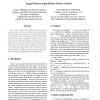886 search results - page 19 / 178 » Learning Distance Functions using Equivalence Relations |
SSC
2007
Springer
14 years 3 months ago
2007
Springer
Bent functions f : Fm 2 → F2 achieve largest distance to all linear functions. Equivalently, their spectrum with respect to the Hadamard-Walsh transform is flat (i.e. all spectr...
KDD
2007
ACM
14 years 10 months ago
2007
ACM
A good distance metric is crucial for many data mining tasks. To learn a metric in the unsupervised setting, most metric learning algorithms project observed data to a lowdimensio...
BMCBI
2007
13 years 9 months ago
2007
Background: Protein-protein interactions are critical for cellular functions. Recently developed computational approaches for predicting protein-protein interactions utilize co-ev...
ICPR
2000
IEEE
14 years 10 months ago
2000
IEEE
We describe a method for learning statistical models of images using a second-order hidden Markov mesh model. First, an image can be segmented in a way that best matches its stati...
ICDM
2005
IEEE
14 years 3 months ago
2005
IEEE
Adaptive clustering uses external feedback to improve cluster quality; past experience serves to speed up execution time. An adaptive clustering environment is proposed that uses ...

